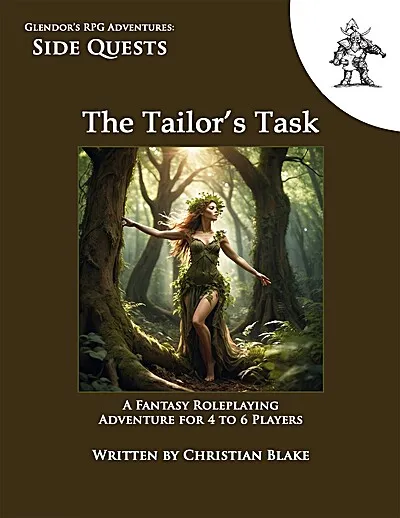Book Review: The Tailor's Task
Review of The Tailor's Task by Christian Blake
 Review Summary: Planned randomness ripe for dissection.
Review Summary: Planned randomness ripe for dissection.
Synopsis: An adventure module in which a tailor sends a party of adventurers off to retrieve a macguffin in exchange for which he promises to use said macguffin on their behalf. The adventure is set in the usual pseudo-medieval fantasy world and, thanks to sliding adjustments, can be run for any level party in any genre appropriate rules set and setting. Or so it says.
Review: The Tailor's Task claims it can be used in a variety of fantasy adventure settings, though, clearly, it is intended to be slotted into an ongoing campaign in Dungeons & Dragons above anything else. If a game master wanted to take it into a different rules set, most of the heavy lifting will be left up to them to make any necessary adjustments. Even in D&D there is still a fair bit of adjustment to be made to the NPCs and their abilities. Not only in order to provide basic abilities and statistics, but also to adjust them to parties of higher or lower level than the NPC would normally be found in any of the fifth edition monster manuals.
Fortunately, there is a provided Read Me text in which the system of adjustment is explained. The primary concern seems to be balancing NPC hit points with damage output per turn. The balance point appears to be the NPCs listed stats in the MM (or where ever they are normally found). Where a lower difficulty is desired, damage per turn is reduced and hit points go up. Where a higher difficulty is wanted, the opposite tack is taken. Which means that parties that are not within a couple of levels of the normal level of the NPC meet a creature that soaks damage like a sponge while not itself dishing out the pain to the party, or a creature that nukes one character a turn but folds up like tin foil at the first reasonable hit. Ideally, you'll want your group near the encounter's natural level to really feel much of a challenge.
Encounter design is somewhat lacking, though. While maps are provided for each major encounter location — and they’re decently crafted using Dungeon Alchemist — none of the encounters really take advantage of the map’s details. Mostly encounter strategy and NPC tactics are left up to the GM to decide and implement. A solid working knowledge of each NPC's abilities will be necessary as no help is given in the text.
Similarly poorly implemented are motivations for the various encounters. Creatures and adversaries turn up and attack the party in various ways simply because it "is pure evil and will show no mercy" or similar. Granted, this is often a fine enough excuse for some groups to do battle to the death, but any party with players more inclined toward interaction or social role-playing will find themselves without opportunities for negotiation or diplomacy during most of the encounters.
At its core, The Tailor’s Task is a straightforward hack-and-slash fetch quest with multiple steps. The party is given clear instructions at the outset on what they need to do and how to do it, leaving little room for alternative solutions or creative problem-solving. Situations don’t evolve or unfold organically — they simply happen. If your group enjoys this style of play, where the adventure is about checking boxes and following instructions without much exploration or deviation, this might suit them. Just go do the thing, as instructed, and don’t look around too much.
However, groups that favor story and encounter variety, groups looking to exercise their social skills, and groups that enjoy puzzle solving or out-thinking their opponents should probably look elsewhere. There's no real cohesive story to grab onto unless it is provided by the GM themselves. There's no common thread with each encounter that leads logically into the next one until you reach the climax at the end. We're not telling a story here, we're just doing things to get a thing because that thing is a thing someone wants. There's no repercussions to consider here, especially since the reward is just some artificially boosted stats.
All in all, The Tailor’s Task feels like a collection of unrelated encounters the designer had on hand and stitched together into a module without much thought for narrative flow or structure. The fact that some of the most potentially interesting bits are themselves located in random encounter tables throughout the module only serves to reinforce this impression. If you do pick up this module, the best use for it might be to disassemble it and sprinkle the various encounters into your regular campaign as filler when you’re out of ideas or need to kill an extra hour on game night.